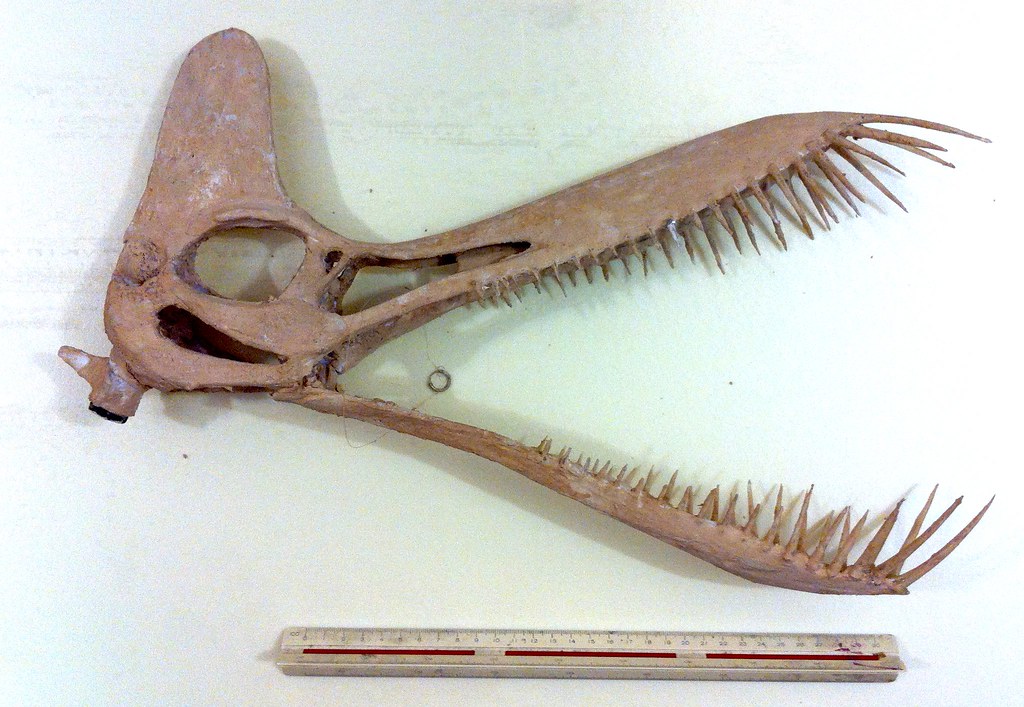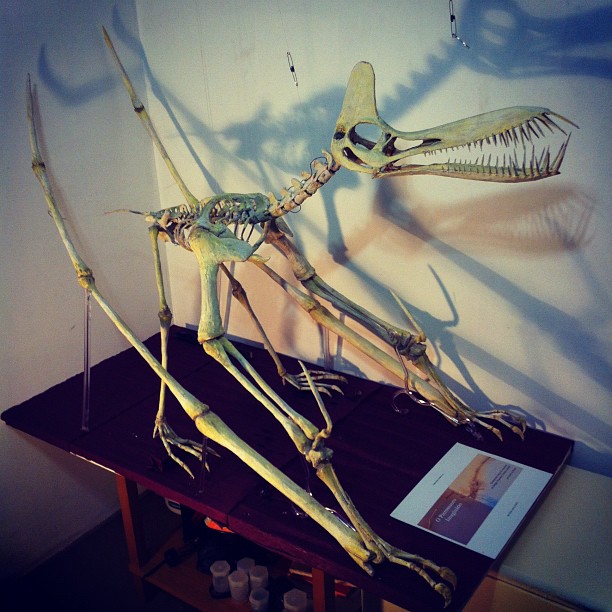Paleontologists in northeast China have discovered a wildly snaggle-toothed skull that belonged to a previously unknown, 120-million-year-old flying reptile.

Paleontologists in northeast China have discovered a wildly snaggle-toothed skull that belonged to a previously unknown, 120-million-year-old flying reptile.
Named Guidraco venator, which is Chinese and Latin for “ghost dragon hunter,” the meat-eating pterosaur had a wingspan of between 13 and 16 feet. The basket of pointy teeth at the end of its foot-long skull probably helped it catch fish, and a round sail on its head may have stabilized flight.

“This is really an amazing fossil, but the funny thing to me is that it was found in Asia. It looks very similar but not identical to pterosaurs found in Brazil,” said Eberhard “Dino” Frey, a paleontologist at the State Museum of Natural History in Karlsruhe. Frey was not involved in the work, published online Feb. 22 in Naturwissenschaften.
The closest relative to G. venator may be a fossil Frey and his colleagues recovered in 2003, called Ludodactylus sibbicki, adding further evidence that now 40 known species of pterosaurs were more globally distributed than previously thought. “The longer we search, the more of these animals turn up,” Frey said.

Pterosaurs were highly successful reptiles (not dinosaurs, as they’re commonly mislabeled) that lived between 210 and 65 million years ago. Although insects took to air first, pterosaurs are recognized as the first flying vertebrates.
Most of their fossils are found in formerly arid plains or river valleys, suggesting the animals primarily dwelled inland. All pterosaurs are thought to have eaten meat, and two crucial features suggest G. venator ate fish: Its 2-inch-long teeth appear suited to trapping fish from water, and pieces of fossilized poop found near its head are full of fish vertebrae.

Whether pterosaurs scavenged, hunted or pursued both strategies, however, is an ongoing debate for many species, including giant pterosaurs known as Quetzalcoatlus. The new G. venator is no exception.
‘Just imagine yourself as this creature. How would you catch living fish with such needles?’The new study’s authors — paleontologist** Alexander Kellner of the Federal University of Rio de Janeiro and Xiaolin Wang, Ahunxing Jiang and Xin Cheng of the Chinese Academy of Sciences — could not be reached for comment, but wrote in the study that *G. venator *likely hunted actively for fish.

Most pterosaur fossils have turned up in silty and fine-grained sediments in what is now Brazil, but the new find, from the Jiufotang Formation in northeast China, adds an interesting twist to the evolutionary histories of pterosaurs.
“[I]ts similarities to some Brazilian pterosaurs show that these animals were probably distributed globally,” paleontologist David Martill of the University of Portsmouth, another pterosaur researcher who wasn’t involved in the study, wrote to Wired.

“We can [now] hope to find them anywhere in the world where early Cretaceous strata crop out. We have found some tantalising fragments in England, some dating back to discoveries made in the 19th century, that indicate similar animals.”
Frey said it’s only a matter of time before more pterosaurs pop out of the rock. “I don’t think we are at the end of the findings,” he said. “We’re going to see more and more overlaps and discover only a few species were endemic to a region.”

Images: Xialin Wang et al./Naturwissenschaften/Springer





